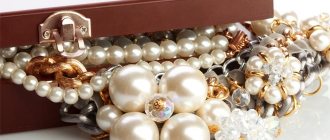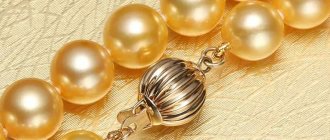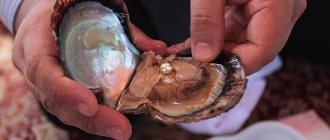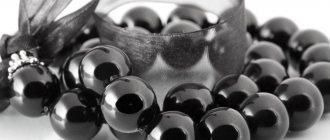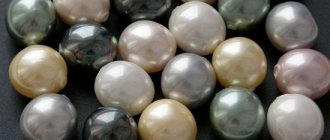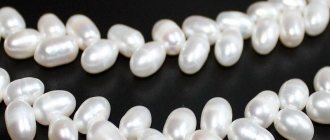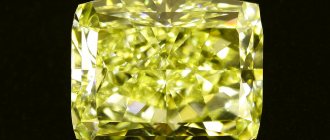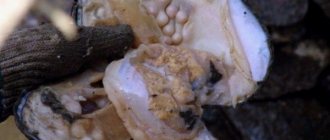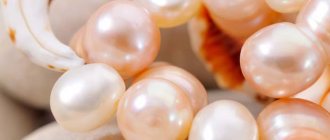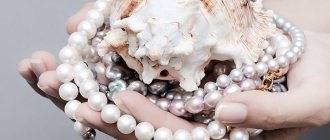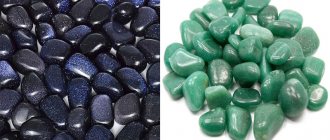Pearls are one of the most ancient precious stones, which are actively used in jewelry and in the creation of beads. It is of absolutely organic origin, as it is formed in the shell of a mollusk. Under natural conditions, pearls are a reaction of the oyster’s body to the invasion of a foreign body, for example, a grain of sand or a parasite. Mother of pearl performs a protective function and envelops the trapped element layer by layer.
Pearls are rare in nature: out of 300 mollusks, only 1 can contain a precious stone. Therefore, jewelry with mother-of-pearl has not only attractive beauty, but also high cost. Fraudsters take advantage of this by passing off painted plastic balls as natural stones. Therefore, it is important to know how to distinguish pearls from fakes.
- X-ray
Types of pearls in jewelry
In order to understand which pearls are better, you need to understand their types. There are several types of gemstone:
- river;
- nautical;
- cultured;
- ennobled;
- artificial.
Real sea pearls are the most expensive stone. It is rarely mined. Freshwater pearls are smaller in size, but are much more common in nature. Freshwater mollusks contain up to 7-8 stones.
Cultured freshwater and sea pearls are most often found in jewelry stores. It is obtained from oysters grown in special reservoirs. Foreign bodies, such as glass beads, are introduced into them, which simplifies the process of obtaining mother-of-pearl. It covers the base with a thin layer.
When harvesting pearls, not all gemstones have an attractive shape or color. The marriage is exposed to x-rays, which changes their hue. Sometimes additional coloring is used. Such pearls are called refined.
Imitation pearls are plastic beads that imitate a precious stone. They are actively used in costume jewelry and in the manufacture of cheap jewelry.
There are differences in natural stones and in the place of their extraction. The most popular pearls are obtained from:
- in the Persian Gulf;
- in the Red Sea;
- off the coast of India and Japan;
- in China;
- off the Ceylon Islands;
- in Indonesia;
- in the Gulf of Mexico;
- in the Caribbean;
- near the island of Tahiti.
Which pearls are considered the most valuable?
The most valuable are natural sea pearls. It is large in size, since the biochemical composition of salt water contributes to the intensive production of mother-of-pearl. Freshwater pearls are also valuable, but are much more common. The reason for this lies in the fact that freshwater mollusks contain up to several dozen stones.
Cultured pearls are less valuable. It is not considered a fake if information about its origin is not hidden. Under human supervision, up to 20 pearls are grown inside each oyster. 98% of the stones sold are the cultivated variety.
Treated pearls are even less valuable. It goes on sale after special processing, often using x-rays. Treated stones are sometimes passed off as black pearls.
Imitation pearls using glass or plastic have the least value. Such beads are widely used in jewelry. Most fakes are made from cheap materials coated with low-grade paint.
The value of a pearl is influenced by its color, luster and surface uniformity. The size of the gemstone also matters. It is desirable that the pearls have the correct shape.
Parameters influencing value
Which pearls are better: sea or river pearls?
There is no clear answer to the question of which pearls are better. Each type has certain advantages. Marine has larger sizes and higher cost. It is often counterfeited, passing off plastic beads and ennobled stones as the original.
Freshwater pearls are cultivated on a large scale. It is actively grown in shellfish in former rice fields in China. The selection of the introduced seed nucleus allows one to obtain a variety of sizes and shapes. This increases the demand for freshwater gemstones.
When growing freshwater pearls, farmers monitor water levels. They turn the oysters in a timely manner so that the stones do not turn out one-sided. A person influences all external growth parameters, but does not artificially increase nacre. All processes occur naturally inside the mollusk. Maintaining optimal conditions allows you to achieve the correct shape of pearls. This is the main advantage of river gems.
Criteria influencing the assessment
There are several characteristics that allow you to evaluate the quality and affect the cost of freshwater pearls:
- Gloss intensity is one of the most important criteria. The glow should be deep. To evaluate this parameter, you need to carefully examine the pearl under a light source. The best specimens are those in which the boundary between the brightest and darkest areas is clearly defined. Such stones are more expensive.
- Thickness of the mother-of-pearl layer. The longer the pearl is in the mollusk, the thicker its nacre shell. A high-quality bead can retain its beauty for several hundred years. A high-quality specimen can be identified by the following characteristics: the stone is cool and weighty, layers of mother-of-pearl are visible in the drilled hole, the reflection is uniform.
- Surface quality. Natural mother-of-pearl beads may not be perfect, but the fewer defects on its surface, the better quality it is.
- Pearl shape. The most expensive stone is considered to be a perfectly round stone, followed by oval or teardrop-shaped stones. Baroque stones that have an irregular shape have the lowest price.
- Size. The diameter of freshwater pearls ranges from 3 to 11 mm. The larger the circumference of a pea, the more expensive it is.
- Color. The white shade of pearls is considered classic. In addition, beads in cream, white-pink, and light brown shades can be found on sale. You need to evaluate color saturation under a lamp on a light surface.
- The similarity of pearls in decoration. If high-quality pearls were used to create the product, then the degree of their coincidence should be high.
These are the main parameters that will help you choose high-quality freshwater pearls.
Types of pearls by color
Pearls boast a rich natural palette of shades. It can be white, yellowish, black pink, blue, cream, green, silver or any other. The further the shade is from white and the brighter the color of the bead, the more attractive and expensive it is.
Varieties of color
Shine
The shade of the gemstone depends on the characteristics of the mollusk’s organism. Therefore, not only light beads are found in nature, but also exotic black ones. They are actively harvested in Tahiti from oysters of the species Pinctada margaritifera. This is the only black pearl that is completely natural. The remaining black beads are either dyed or obtained by x-ray irradiation.
Black beads
Imitation black sea pearls are made from cheap river pearls. It is refined by exposure to radioactive radiation. The stone takes on a dark gray color with a metallic tint, unnatural for nature.
Mostly freshwater pearls are suitable for radiation enhancement. If you irradiate the sea, the impact will go to the core. It will darken and become visible through the outer layer of mother-of-pearl.
Original pearls often have an uneven color. There are spots with more or less shine on the surface. The coloring of fakes is always the same.
Dark pearls are also obtained by treating them with silver nitrate. Sea stone takes on a silvery tint, while river stone takes on a grayish tint. It also has a metallic artificial shine.
Why is it different?
A pearl is formed by a mollusk when a foreign substance enters the shell. The final result depends on the type of “house”, the composition of the water, and the ripening time of the pearls.
The pearlescent secretion produced by sea mollusks is not the same as that of river mollusks. The water of the seas and oceans is richer in chemical and biological diversity of elements. Therefore, sea and river (also called freshwater) pearls are not the same externally and internally.
Types of pearls by shape
The shape of natural pearls is most often slightly irregular. Beads are ovoid, pear-shaped, elongated or elliptical. Perfectly round real gems are rare. They are mainly used in rings and earrings. Most round pearls are obtained through cultured methods.
Variety of shapes
Description of types of forms
Hemispherical pearls are often found. It is cultivated mainly in Japan, the USA and China. Such a stone grows directly on the shell itself, and not inside it. This affects the shape of the gem.
Hemispheres are the most common and best-selling. They are cheaper than other types of pearls. Hemispherical gems are used in the manufacture of bracelets, pendants, rings and earrings.
Hemispherical shape
The largest pearls are grown in mollusks that live in the southern seas of Australia, Indonesia and the Philippines. The diameter of the gems reaches 20 mm. The large size is the reason for the high cost of natural stones from the South Seas.
Pearls with attractive shapes are called baroque. If the shapes of the gemstone are similar to the silhouettes of animals or any objects, then these are paragons. Gems of this type often become natural talismans. They are often framed in gold.
Types of forms
Main conclusions
Freshwater pearls are grown on special farms. Externally, freshwater beads are practically no different from sea beads, but they can be distinguished by their shine, shape, color, durability and price.
The leader in stone production is China. Most river pearls are oval or pear-shaped. And their color range is limited: from beige to light brown. The most common size of the mineral ranges from 3 to 5 mm.
To distinguish a fake from an original, you need to pay attention to the weight, surface and edges of the holes of the products. The magical and healing properties of river pearls are impressive, their appearance brings aesthetic pleasure, and the price is much cheaper than sea pearls.
How to distinguish real pearls from artificial ones
When buying jewelry or beads, it is important to know how to distinguish natural pearls from fake ones. This can be done in several ways:
- Through careful external examination.
- With the help of special experiments.
- By contacting a specialist in checking gemstones, that is, a gemologist.
- Using additional equipment.
- Comparing cost and other factors.
Cost of real beads
Only fake jewelry is sold at a low price. Real pearls are expensive. Beads made from the least valuable white gems of irregular shape will cost several thousand rubles. For cultured round stones with a diameter of 15 mm you will have to pay from 2 thousand dollars.
The price is affected by the color, diameter, origin, and shine of the pearl. The cost also depends on the quality of the surface. Therefore, the price varies greatly. On sale, products with natural pearls cost from $15 to $100,000. At auctions, some pearls sell for millions of evergreens.
Cost of jewelry
Inspection with a magnifying glass
Another way to distinguish artificial pearls from fakes is inspection with a magnifying glass. It is important to check the edges around the holes. There should be no visible scratches on the paint. Under a magnifying glass, real pearls can only be seen as homogeneous nacre. When approaching fakes, specks of dye and smudges are clearly visible. To do this, just look at the bead through a 10x magnifying glass.
Inspection with a magnifying glass
Pearlescent surface
How much does a real pearl weigh?
Natural pearls weigh much more than fake ones. Therefore, checking the weight is an excellent method for distinguishing real pearls from artificial ones. The original contains mother-of-pearl, while the fake has plastic or other lightweight material. Even with a small size, a real pebble cannot be weightless.
Compare each pearl by shape
Each real bead has an individual shape. Therefore, comparing all the gems in a necklace or bracelet is one of the ways to distinguish pearls from fakes.
Comparison of gems
Even in the most expensive jewelry it is impossible to use completely identical pearls. They will have slight differences from each other and peculiar defects. If all the beads are perfectly even, exactly the same and without minor natural flaws, then the jewelry definitely contains artificial stones.
Bead comparison
Gloss test
Another way to distinguish natural pearls from artificial ones is to check for shine. A real gemstone has a deep and uniform shimmer. Fake and poorly cultivated gems have no shine. They are usually dull and unattractive.
The surface of the pearl at the drilling site
The holes on the beads should not be chipped or cracked. The original has no traces of paint. If the holes are made with defects, then it is a fake.
Sun check
It is recommended to examine pearls under the rays of the sun. This method works well in street markets. Natural stones will shimmer with a pale blue hue. You can see the core of the fake. They glow greenish or pinkish.
Tooth test
The “tooth test” is a very interesting way to distinguish pearls from fakes at home. The natural gemstone will create a squeak when it touches the enamel. You can bite fakes completely silently.
Tooth test
Tactile test
Mother of pearl has low thermal conductivity, meaning it heats up very slowly. Thanks to this, the beads remain cold for a long time even when they touch human skin. Plastic jewelry heats up quickly from body heat. This is not the most accurate way to distinguish real pearls from fakes, as it is very subjective.
Fall and hit
It is recommended to drop the bead from a height of about 50 cm. A real stone will receive minor traces of impact, which can be easily smoothed out with a finger. Fake pearls made from glass may crack. The plastic bead will bounce off like a ball.
Destructive test
Mother of pearl is a dense substance with low hardness, which is up to 4 Mohs units. Therefore, the gemstone is easy to damage. To do this, just scratch it with a knife.
Causing damage with a knife
Scratching the surface
When exposed to a knife, a thin layer of mother-of-pearl will begin to peel off from the original. It will look like powder. The fake will have chipped paint and expose the artificial core.
Dust from mother of pearl
After scratching with a knife, you need to wipe the surface with your finger. All damage to real mother-of-pearl will disappear and it will return to its original appearance. On a fake, all scratches and paint chips will remain in place.
Mother of pearl after rubbing with a finger
Friction
If you don’t have a hard object at hand, you can rub the beads against each other. The original produces a small amount of dust. Scratches can be easily removed by rubbing the surface with your fingers.
The process of rubbing beads against each other
Chemical test with acetone
Placing a bead in acetone is another way to identify fake pearls. A real gemstone will not react. The paint on a fake will dissolve, and the core itself may be damaged.
Inspecting the bead after acetone
Vinegar test
Testing with vinegar destroys real pearls. Therefore, you should resort to it only by removing one pebble from the beads. Plastic fake will not react with vinegar. The advantage of this method is the ability to identify cultured pearls. After the nacre layer dissolves, its core will become visible.
Reaction to vinegar
Visit to a specialist
If you are unable or unwilling to carry out experiments, you can confirm the authenticity of the pearls from a specialist. Gemologists do this kind of work. They will accurately determine the type of gemstone and its origin.
Information on the tag
Natural pearls are always accompanied by a quality certificate. You must ask the seller before making a purchase. A quality certificate is an additional guarantee of the natural origin of a precious stone.
Ultraviolet
It is harmless to shine ultraviolet light on pearls. Natural stone gives a bluish glow, while artificial stone gives a green glow. Some fakes do not react to UV rays at all. The source of ultraviolet light can be a special flashlight or a device for checking banknotes.
Fire
Natural pearls are not afraid of fire. It can be brought into the flame for a couple of minutes. In this case, the fake glass will crack, and the plastic jewelry will melt.
Healing and magical properties
Freshwater beads are believed to have many healing properties. The mysterious stone accelerates the recovery of many diseases. Beads made from mother-of-pearl beads strengthen the immune system and increase the body's resistance to viral and bacterial infections.
If you have problems with your kidneys, liver or stomach, it is recommended to buy earrings, a necklace or a bracelet made of freshwater pearls. Gems will help normalize the functionality of the nervous system, relieve depression, and make a person calmer and more confident.
There is a method of cleansing the body with river pearls. To do this, you need to lower the mother-of-pearl bead into a glass of water for 15 minutes, and then take it out and drink the liquid. You can also simply hold the pebble in your mouth for 10 - 15 minutes.
This is interesting! Freshwater pearls warn their owner about possible diseases. If a person is sick, the stone becomes dull, which is a good reason to visit a doctor.
The freshwater mineral was used in ancient times as a talisman and a means to prolong youth. Mother-of-pearl beads help improve the situation in the family, protect the house from thieves, evil and deceitful people, unsuccessful transactions and rash actions. The stone helps you quickly find a common language with new people and make good friends.
Freshwater pearls are best avoided by vain, envious, and greedy people.
The freshwater mineral absorbs the bad energy of its owner, taking away his illnesses and problems. That is why it is highly not recommended to make it a family heirloom, otherwise you can bring on various troubles.
How to identify cultured pearls
Cultured pearls are not literally fake unless they try to sell them at the price of a wild stone. It is created under artificial conditions, under which the mollusk actively produces nacre. To do this, a foreign body is placed in the shell, performing the function of a seed nucleus.
X-ray
X-rays can help distinguish natural pearls from cultured ones. With its help you can examine the structure of the mineral. The picture shows the presence of a core, density and number of layers. The disadvantage of this method is that as a result of X-ray irradiation, the jewelry may change color.
Bright light
A safer way to identify cultured pearls is to view the stone in a bright light. It is convenient to use an ovoscope for this. By shining a bright light through the bead, you can see the presence of a seed nucleus in it.
Where is the best place to check?
It is not difficult to recognize the nature of pearls. But how can you check it for sure? It is more convenient to do this in a jewelry salon, where everything is clearly visible and there is no need to rush. You can calmly examine the stone, touch it, and evaluate the texture of the mother-of-pearl.
Tags on jewelry and accompanying documents will help. It's easier to appreciate the differences when you have both views in front of your eyes at once. The assortment of the salon allows this.
Today, pearls of different origins and prices are available. The sea mineral is expensive, but aristocratic.
It is possible to find river specimens grown using the latest technologies. Their aesthetic appeal is not inferior to those obtained from the sea, they are more durable to wear, but more pleasant in price. Therefore, you should proceed from your own financial capabilities, preferences, and purpose of purchase.
